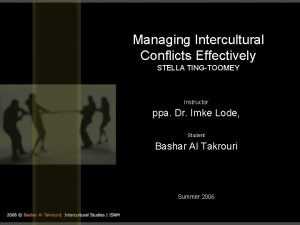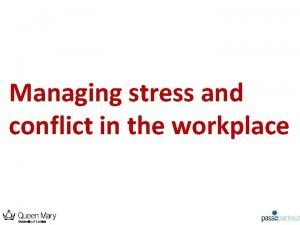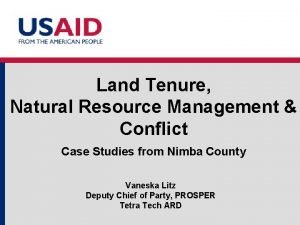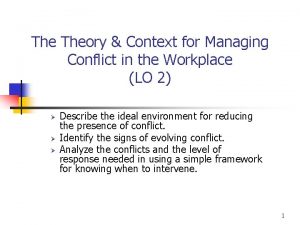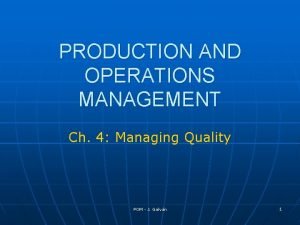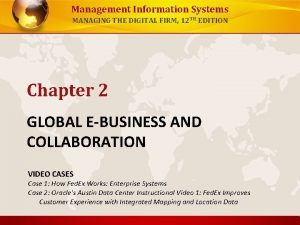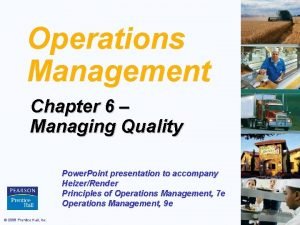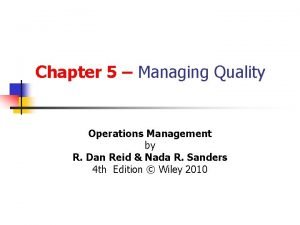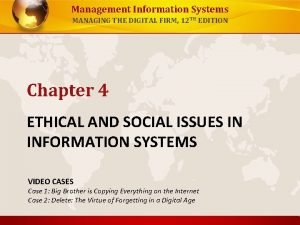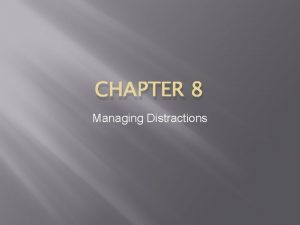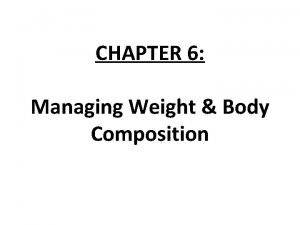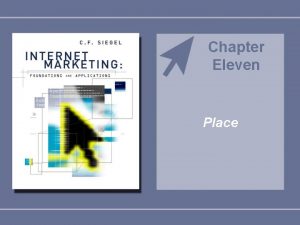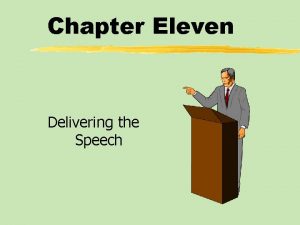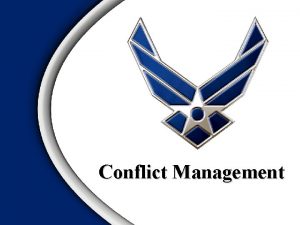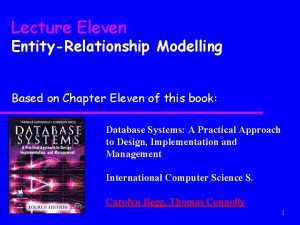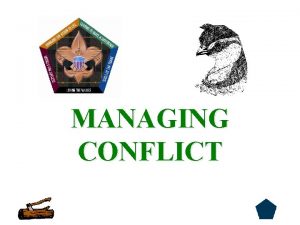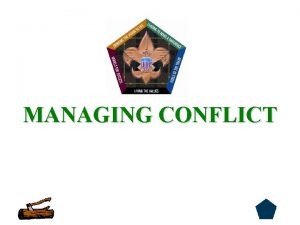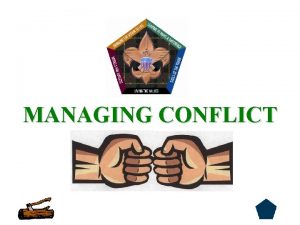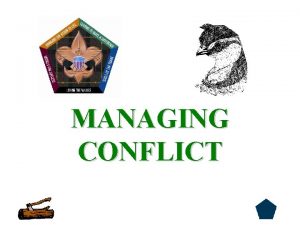Conflict Management Chapter Eleven Managing Conflict J S





















- Slides: 21

Conflict Management Chapter Eleven: Managing Conflict J. S. O’Rourke, IV. University of Notre Dame / USA

Is Conflict Costly? General Motors Corporation lost more than $2. 2 billion trying to win a labor struggle with the UAW in the late-1990 s. Since 1990, GM has experienced 24 strikes, slowdowns, showdowns, and walkouts. GM, incidentally, has the highest cost structure of any domestic auto maker. Copyright © 2013 Pearson Education, Inc. Publishing as Prentice Hall 11 -2

Is Conflict Costly? Industrial psychologists estimate that workplace conflict may have a price tag as high as $30 billion yearly in the United States alone. Worldwide, the cost may be three-tofive times that high. Workplace conflict can exact a toll that is both physical as well as psychological, and productivity suffers as a result. Copyright © 2013 Pearson Education, Inc. Publishing as Prentice Hall 11 -3

Is Conflict Inevitable? “Conflict in any endeavor that requires the input of two or more people is a real possibility. As the scope of a project increases, the likelihood of differences in opinion and approach increases as a function of the number tasks involved and amount of time spent by staff resolving the project. ” Jeanne Gulbranson, President, Key Performance Int’l. Copyright © 2013 Pearson Education, Inc. Publishing as Prentice Hall 11 -4

Is All Conflict Bad? Not all conflict within an organization is unhealthy, but conflict between and among people within an organization can quickly become counter-productive, divisive, and destructive if not properly managed. Copyright © 2013 Pearson Education, Inc. Publishing as Prentice Hall 11 -5

A Definition of Conflict Not all experts can agree on one definition of what conflict is, but most agree that while opposition, incompatibility, and interaction are important ingredients in conflict, a perception of conflict is essential. In other words, if no one thinks a conflict exists, there probably isn’t one. Copyright © 2013 Pearson Education, Inc. Publishing as Prentice Hall 11 -6

What Is Conflict? Conflict is a process that begins when someone perceives that someone else has negatively affected, or is about to negatively affect, something that the first person cares about. Conflict, in practical terms, exists when people disagree to the point that they can no longer cooperate. Copyright © 2013 Pearson Education, Inc. Publishing as Prentice Hall 11 -7

Three Views of Conflict w The Traditional View. w The Human Relations View. w The Interactionist View. Copyright © 2013 Pearson Education, Inc. Publishing as Prentice Hall 11 -8

The Traditional View w Assumed that all conflict was bad. w Conflict was used synonymously with words such as violence, destruction, and irrationality. w Conflict was assumed to be the result of poor communication, a lack of openness and trust between workers and management. Copyright © 2013 Pearson Education, Inc. Publishing as Prentice Hall 11 -9

The Human Relations View w A popular view from the 1940 s to the 1970 s. w This view assumed that conflict was a natural occurrence in all groups and organizations. w Since conflict was inevitable, labor psychologists argued in favor of accepting or embracing it. It cannot be eliminated and may even be beneficial. Copyright © 2013 Pearson Education, Inc. Publishing as Prentice Hall 11 -10

The Interactionist View w Emerged from the social science literature of the 1980 s and 1990 s. w This view actually encourages conflict. A harmonious, peaceful, tranquil, and cooperative group may become static, apathetic, and unresponsive to a need for change and innovation. Copyright © 2013 Pearson Education, Inc. Publishing as Prentice Hall 11 -11

Sources of Conflict in Organizations w Limited resources. w Values, goals, and priorities. w Poorly defined responsibilities. w Change in the environment, the marketplace, society, or the economy. w Human drives for success, competition. Copyright © 2013 Pearson Education, Inc. Publishing as Prentice Hall 11 -12

Sensing Conflict w Visualize conflict by asking who, what, when, how, where, and why? w Give feedback to others. w Get feedback from others. w Define expectations. w Review performance regularly. Copyright © 2013 Pearson Education, Inc. Publishing as Prentice Hall 11 -13

Some Benefits of Dealing with Conflict w Stronger relationships. w Increased self-respect. w Personal growth and development. w Improved efficiency and effectiveness. w More creative, non-traditional thinking. w Greater synergy and teamwork. Copyright © 2013 Pearson Education, Inc. Publishing as Prentice Hall 11 -14

Styles of Conflict Management Assertiveness High Competing Collaborating Compromising Avoiding Accommodating Low High Cooperativeness Copyright © 2013 Pearson Education, Inc. Publishing as Prentice Hall 11 -15

Styles of Conflict Management w Competing: people who are assertive and uncooperative. w Collaborating: people who are assertive but cooperative. w Avoiding: people who are both unassertive and uncooperative. w Accommodating: people who are unassertive but cooperative. Copyright © 2013 Pearson Education, Inc. Publishing as Prentice Hall 11 -16

Styles of Conflict Management w Compromising: people who are at the midpoint on both assertiveness and cooperativeness. Compromise occurs when each party to a conflict demonstrates a willingness to give up something in order to promote a solution. Copyright © 2013 Pearson Education, Inc. Publishing as Prentice Hall 11 -17

So, What Should You Do? w Listen, listen, and then listen some more. w Separate the people from the problem. w Focus on interests, not positions. w Recognize and accept the feelings of the individuals involved. Copyright © 2013 Pearson Education, Inc. Publishing as Prentice Hall 11 -18

So, What Should You Do? w Keep your own emotions in neutral. w Track the conflict to its source. w Communicate continually and honestly. w Get people together on the small stuff first. Copyright © 2013 Pearson Education, Inc. Publishing as Prentice Hall 11 -19

So, What Should You Do? w Devise options for mutual gain. w Define success in terms of gains rather than losses. w Follow up to ensure success. w Know when to cut your losses. Copyright © 2013 Pearson Education, Inc. Publishing as Prentice Hall 11 -20

Copyright © 2013 Pearson Education, Inc. Publishing as Prentice Hall 11 -21
 Eleven book sandra cisneros
Eleven book sandra cisneros Managing intercultural conflict effectively
Managing intercultural conflict effectively Techniques for managing organisational relationship
Techniques for managing organisational relationship Managing conflict and negotiation
Managing conflict and negotiation Managing stress and conflict in the workplace
Managing stress and conflict in the workplace Ways of managing conflict in the community
Ways of managing conflict in the community Managing conflict theory
Managing conflict theory Managing quality in operations management
Managing quality in operations management Managing assets vs asset management
Managing assets vs asset management Managing assets vs asset management
Managing assets vs asset management Management information system managing the digital firm
Management information system managing the digital firm Chapter 6 managing quality
Chapter 6 managing quality Snmp uses two other protocols
Snmp uses two other protocols Introduction to network management
Introduction to network management Managing quality in operations management
Managing quality in operations management Management information systems managing the digital firm
Management information systems managing the digital firm Chapter 1 managing risk when driving
Chapter 1 managing risk when driving Chapter 8 managing stress and anxiety
Chapter 8 managing stress and anxiety Leasiest
Leasiest Projectile drivers ed
Projectile drivers ed Chapter 8 managing distractions answers
Chapter 8 managing distractions answers Chapter 6 managing weight and body composition
Chapter 6 managing weight and body composition

